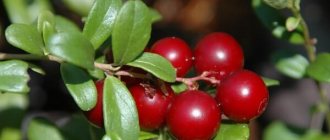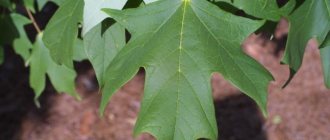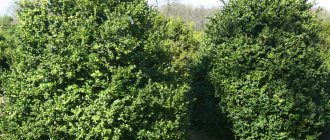Hello dear reader!
Why did I decide to write several articles on my blog about different types of willows? Most of us will not confuse willow with some other tree or shrub - birch, alder. The appearance of willows of different species has many common features that unite them. And the properties and uses of willows are similar, regardless of the exact species.
But for some reason it seems wrong to me when a user, interested in the question of what goat willow is, receives in response information, strictly speaking, about the characteristics of the genus Willow (Salix). And sometimes with a picture depicting a plant of a different species - for example, white willow (willow). Alas, there is such a thing...
Of course, I’m unlikely to tell you about all types of willows - there are more than fifty of them known! But about some - with pleasure!
Characteristic
An adult tree is relatively small - up to six meters. The roots are branched in all directions, which gives additional advantages on rocky soil.
The main advantage of willow is its appearance, regardless of the season. In spring, so-called seals appear, then foliage appears, which acquires an unusual color by winter.
Separately, it is worth mentioning the shoots - here they have a flexible, twig-like shape and reach the soil. With a sufficient level of sunlight, a lush crown is formed on the tree, which will only add to the aesthetics of the plant.
Uses of goat willow
Goat willow bark contains tannins used in tanning. Thin leather intended for making gloves, as well as morocco, is tanned using the tanning extract of the bark of this tree. The bark is also valued in folk medicine. It is an astringent, antipyretic, wound-healing, choleretic and sedative. A decoction of the bark is used for colds and rheumatism, diseases of the spleen and gall bladder.
In addition, goat willow bark contains biologically active compounds: flavones, tannins, glycosides, vitamins, and minerals. Fresh willow leaves are applied to calluses to soften them. For tuberculosis of the joints, take baths with an infusion of willow leaves. Male inflorescences in the form of an alcoholic infusion or a water decoction help with neuroses and disorders of the cardiovascular system.
For stomatitis and gum disease, a decoction of the bark is used to rinse the mouth. Goat willow is also an effective remedy for excessive sweating. To normalize the functioning of the sweat glands, a decoction of the bark is taken orally.
Willow preparations are not recommended to be taken during pregnancy and breastfeeding, as well as along with aspirin, laxatives and vitamins.
Goat willow wood is used as a construction, ornamental and material for making furniture and household items. It also serves as fuel. The branches are a material for creating fences. The leafy branches are used to feed livestock, especially goats and sheep. Bredina leaves are used as a tea substitute. In the Caucasus, an intoxicating drink is made from the male earrings of this tree.
Goat willow is considered an excellent honey plant, valuable for beekeeping. From the tree, bees take nectar, pollen, honeydew, and sticky bud secretions, which the bees turn into propolis.
During the flowering period, the branches of the willow serve as decoration for the room, and where there is no real willow, they are used in Easter rituals.
The bark is collected before the willow flowers, during sap flow. The bark removed from the tree is dried in the sun and dried in the oven. The finished raw material should not bend, become hard and brittle. Store the dried bark in a box. Shelf life: 4 years.
Baskets of different shapes and purposes are woven from the twigs of this tree. A thin willow rod combines flexibility and elasticity. Craftsmen use peeled twigs to make small products convenient for picking berries, and large baskets with which you can go mushroom picking. Neither mushrooms nor berries wrinkle in them. For harvesting potatoes, special baskets made of willow twigs are used, which are called “potato” baskets. There are wicker products for storing papers, there are also flower baskets, they are used to decorate the festive table.
Bread bins, candy bowls, crackers and other kitchen utensils are woven from the vine. A beautifully woven vase will decorate any table, both formal and everyday. One-year and two-year-old willow shoots, long and thin, are suitable for weaving baskets.
Where to plant?
Goat willow does not like strong drafts and the shady side. The upper part of the root system reacts sharply to a lack of moisture - to prevent such an incident, use drainage when planting. Also, for the planting hole, it would not be superfluous to fertilize in the form of humus, compost or peat - this will significantly accelerate the growth of the future tree.
It is best to use fresh and light loam for willow growth, but in general, the plant is unpretentious in choosing soil. The main condition is the absence of limestone inclusions.
The main area of application of goat willow is parks, squares, and ponds. You can often find hedges made from such plants, and they look very good, especially in combination with other vegetation.
Short description
The plant loves light, however, it has shade-tolerant qualities. Favorite growing areas: fertile, rich, sandy or gravelly soils. At the same time, they should not be very wet - this can destroy the tree. As a conclusion, watering should be moderate. Broom is found along roads, houses, in forest clearings, and clearings. Formed seedlings are used for planting. If you need to propagate, then cuttings, seeds or a grafting method are suitable for this.
The characteristic features of the plant are:
- Branches . They are thick and spreading. In young individuals they have a slightly grayish color and slight pubescence. In mature and well-developed specimens, the color of the branches may be greenish-gray or yellow-brown. If the tree is old, then its branches become gray in color and become brittle.
- Bark. At first it is green-gray in color and quite smooth. As it matures, the color changes to brown, and cracks form at the bottom of the trunk. As for wood, it is smooth, but when it comes into contact with air it turns red.
- Foliage. It has an elliptical shape with a length/width of 11-18/5-8 cm, respectively. The outer side is dark green, and the lower side is grayish. A distinctive feature is a jagged, uneven edge. The buds are hidden in the axils of the leaves. They are quite large (length-width 5/3 cm, respectively). Flower buds are reddish in color and ovoid, not flattened, measuring 15/3-6 mm in length/width.
- Flowers in the form of earrings. Goat willow blooms in April, before the foliage begins to grow, and lasts 10-13 days. There are female and male flowers. The first are wide, oblong-oval, up to 6 cm long. The second are dense, cylindrical, reach 10 cm in length, multi-flowered.
- Fetus. As a result of pollination in May, a fruit is formed in the form of a box with a diameter of about 7-8 cm, located on a fluffy petiole. Each fruit contains about 18 seeds with fluffy outgrowths, thanks to which the seeds are transferred over a distance. Unfortunately, the seeds lose their viability very quickly.
When to plant seedlings
When planted in spring or autumn, the plant will have time to “settle” well and acquire roots. Therefore, these periods are most suitable for planting a new tree.
Only planted willow requires regular watering - in the first seven days, it should take more than twenty liters of liquid. If a dry period occurs, the amount of water increases.
Varieties
Most often, gardeners pay attention to such varieties of willow as “Silberglanz”, which has a height of up to 8 m and a spreading crown, “Pendula”, the main advantage of which is a weeping crown and standard form, and “Mas”, which has a wide spreading crown and reaches a height of up to 10 m
Goat willow Pendula
This is a deciduous tree, reaching a height and length of up to 2-3 m. As a rule, it lives no more than 30 years on soils of any moisture content.
The variety is shade-tolerant and light-loving. For normal growth, abundant watering is required. But to avoid overflowing, a fairly high drainage layer should be laid. The plant is frost-resistant, but it is recommended to cover the trunk for the winter. The advantage of the plant, we repeat, is the tent-shaped weeping crown. Goat willow looks great on a trunk. Of the many varieties, pendula can be identified by its dark green oblong-elliptical foliage up to 8-10 cm long. In autumn, the color turns yellow.
In April-May, flowering begins (lasting 15 days) with the release of flat golden-yellow catkins. Subsequently, the fruit is formed in the form of a box.
In landscape design, pendula is planted as a single tree or in decorative groups. Looks great in rock gardens and near ponds. It goes well with dwarf trees of coniferous varieties, young plants, moisture-loving plants and ground covers. As for reproduction, the procedure is performed by grafting onto a standard.
The most difficult to care for is pruning the goat willow variety Pendula. If the crown is not formed correctly during the first year, the branches will fall to the ground and the decorative value will be lost.
In young animals, all branches are pruned, leaving a length of only 15 cm. In this case, a bud should remain, looking to the side or upward. But not inside the crown. This haircut achieves a shape similar to an open umbrella.
If the plant is mature, then pruning is carried out after flowering, shortening the branches by 2/3 of the entire length. This achieves dense branching of the crown.
Goat willow Kilmarnock
This variety is distinguished by its miniature size (maximum 1.5 m in height). The tree is standard and resembles an open umbrella with branches reaching to the ground. The plant is frost- and wind-resistant, light-loving. It has no soil requirements and grows well on low-calcareous, loamy soils. The only drawback is sensitivity to moisture, so you need to be careful with watering.
The variety can be identified by its foliage. It is green, oblong-elliptical in shape, slightly wrinkled, turning yellow in autumn.
In April, flowering begins with the release of numerous catkins with silvery and fragrant flowers.
Care
This plant cannot be ignored - it requires regular care, especially if you want to get a neat tree. First of all, this is willow pruning and fertilization. As soon as the growing season begins, use complex fertilizers. Until the dormant state, two more feedings are recommended, and the last one should consist of potassium sulfur or superphosphate.
In order for a young tree to quickly form, it will require caring for the soil around it, as well as the destruction of weeds. Mulching using expanded clay, paper, sawdust is an excellent solution for this. If the soil is too dry, it needs to be loosened.
As for pruning, it should be regular, and the optimal height is half a meter. Dry and unattractive branches are removed so that the crown is formed correctly.
Nothing extra
It is recommended to start pruning a tree from the first year of life. All shoots are cut off, leaving only 15 cm and one healthy bud, which should look up. This is the beginning of the formation of a regular and beautiful willow crown. Mature trees also need pruning, but do this after flowering. To make the willow thick, all shoots are shortened by 2/3 of the total length. Do not forget that all dry and diseased branches are removed immediately. As a result, you should have a tent-shaped tree with strong, healthy and beautiful shoots.
For proper and timely care, willow will thank you with its amazing flowering. It is worth fighting not only with branches, but also with diseases and various pests.
We grow on a standard
To grow goat willow on a trunk, you will need certain varieties of this tree, primarily “Pendula”. If you decide to use this method, the young shrub should be trimmed correctly to form the desired crown. Otherwise, the branches will fall to the ground and grow there.
When removing a young standard willow, you need to remove a young shoot, the length of which does not exceed fifteen centimeters. The remaining bud should be turned away from the green massif, otherwise the crown will turn out ugly. Once the mature tree has finished blooming, it also needs to be pruned.
Willow is propagated on a trunk by grafting, but this method is very complicated and is not always possible for plant owners. It is best to use seedlings from a nursery.
- Plot near a pond: nuances of choice
- Which fast-growing shrubs are suitable for green fences?
- Juniper stricta - description, cultivation, planting and care. Secrets of garden maintenance and application in landscape design (130 photos and videos)
Dangerous diseases of a miniature tree
Nevertheless, sometimes the decorative beauty is attacked by the following pests and diseases:
- leaf roller - harms the tree in the caterpillar stage, which can be gotten rid of by spraying the shoots with chemicals;
- flower fly - often removed after watering the soil with a solution of potassium permanganate;
- powdery mildew is a fungal disease that spreads quickly; to get rid of it, it is necessary to remove the affected leaves in a timely manner;
- black spotting occurs when leaves come into contact with water; To avoid disease, the tree should be planted in a windy place.
Problems and their solutions
Although this tree is not considered susceptible to diseases, sometimes they can make themselves felt. If a white coating is detected on the leaves, we recommend using special antifungal drugs, otherwise the crown will quickly fall off.
The use of fungicides is suitable when black spots appear on the leaf mass. To prevent this from happening, we advise you to carefully monitor the soil. You should water at the root, not the entire tree.
The main points of grafting
What rules must be followed in order to grow a beautiful standard tree that is pleasing to the eye and harmoniously fits into the design? Here's a quick step-by-step guide:
- Grow the base (or standard). The young seedling is tied to a support and allowed to develop to a certain height.
- Take a healthy cutting with two to four living buds.
- Make an oblique cut above the upper bud of the cutting (scion), and in the lower part, using two cuts, create something like a wedge.
- Using a pointed section (wedge), carefully insert the scion into the trunk so as not to damage the latter.
- Treat the junction area with garden varnish and tie it with a plastic bandage or electrical tape, which can be replaced with new ones over time, and after a year completely removed.
- After a month, the cutting should take root and new buds will appear on it. Freshly baked shoots will soon form, and as soon as they grow twenty centimeters, they will need to be pinched properly.
Manipulations with vaccinations should be carried out in the spring, in dry sunny weather, so as not to introduce bacteria, fungi or infections into the junction.
It is recommended to regularly feed grafted trees with nitrogen fertilizers (preferably twice a summer), and also treat them against diseases and pests for preventive purposes.
What to do if the grafted shoot does not take root? It’s okay, you can try again soon, but it is recommended to do this a year after the unsuccessful vaccination.
Recently, gardeners have begun to use not only standard trees, but also shrubs. What does this actually look like?
Properly protect the plant from scab
- From heavy rains in spring or autumn, willow can become infected with scab. It’s easy to identify the problem - the crown looks like it’s been burned by fire. You need to fight the disease like this: all damaged shoots are cut off and burned, and do the same with fallen leaves. Treat the damaged areas with copper sulfate and cover with oil paint.
Natalia Semenova:
Stone_Pine, it looks like a fungal disease. It might be willow scab. Many types of willows are susceptible to it, especially weeping forms. Rains in spring and autumn contribute to the disease. With massive scab damage, the crowns of diseased trees take on the appearance of being scorched by fire.
In the spring, after the leaves bloom, a dark olive coating forms on the upper side of the leaf blades, consisting of mycelium (mycelium) and sporulation of the pathogen. Affected leaves turn black and die. From here the mycelium penetrates into the shoots. They turn black, become deformed and die.
Now remove all affected branches and burn them. In the fall, collect all the foliage and burn it. After removing diseased branches, be sure to treat the wounds with 1-3% copper sulfate and then it is advisable to cover them with oil paint based on natural drying oil. Spray the plant with fungicides now and in early spring. And in the spring, starting 10–14 days after the leaves bloom, with an interval of 2–3 weeks, spray the willow with fungicides 3–5 times.
- Do not plant goat willow on a trunk in regions with cold winters. Only the usual unvaccinated options are suitable there.
Dune HD:
Please tell me, will the goat willow Pendula (Kilmarnock) live on the trunk in Novosibirsk? Or is it better not to try and not torment the plant?
Mountelf:
Planting seedlings
The tree grows well in slightly acidic soils. If the soil is very dense, the soil is mixed with sand. For dwarf varieties, a layer of expanded clay is placed on the bottom of the pot for drainage.
Planting a globular willow seedling:
- Dig a hole 0.5 meters deep.
- The excavated soil is combined with fertilizers.
- The prepared branch is inserted and covered with the resulting earthen mixture.
- At the end of planting, the young tree is watered abundantly.
How to grow a weeping beauty?
So, if you decide to make the site interesting, goat willow Pendula is considered an excellent option. Planting and care, photos of which are shown below, testify to its uniqueness. Let's take a closer look at the nuances of planting.
Willow grows on any soil. It is considered one of the few representatives of unpretentious plants. If you want to choose the ideal location for the tree, then medium loam is suitable. Even close groundwater does not prevent the plant from fully developing. Next, we carry out the landing according to the following algorithm:
- We prepare a hole measuring 50*50*40 cm (width, length, depth).
- Add compost, humus, and peat. Everything should be in equal proportions.
- Don't forget about mineral fertilizer. It is enough to pour about 300 grams of it per plant root.
- Mix all the contents of the pit thoroughly.
- Now you can plant the tree.
- At the end of the work, do not forget about thorough watering.
Goat willows take root easily. Planting can be carried out for seven months - from April to October - provided that the tree has a closed root system. You need to keep an eye on it so that it doesn’t dry out. If the plant has open roots, then it is better to plant in early spring, before the first buds appear, or in early autumn, preferably in September. So we found out how Pendula goat willow grows. We'll look at caring for wood next.











